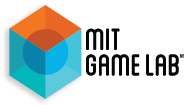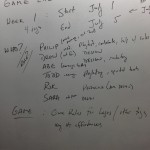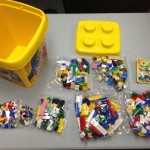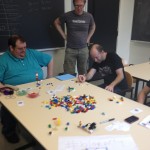Experiments in rapid prototyping, part 2
This is part 2 of a series of blog posts about our first summer rapid prototyping experiment. See part 1 for the background.
We’ve had one development week so far. During the week of July 4th, we had only about 3 days worth of development, and many of those days were not shared by everyone involved. This interesting constraint led to the development of #bloqprty – a simple party game played with a set of cards that we created and building toys (we used LEGO® for this prototype, but designed the game to be flexible enough for any other kind of construction toy).
This first project turned out to be the perfect first project for our process. On Monday, we started with the goal of creating a game for commercial building toys that takes advantage of their affordances. Our interpretation of this is that the verbs used when playing with the toys should be natural verbs used within the game. How do people usually play with LEGO®? They build things; sometimes with a plan, but often with a general idea and a lot of trial and error. They show their creations off. If playing with a group they often laugh at the silly things that they made. At the end of the day, we had created a card-based party game that provided structure to this natural play by combining the rule changes of Fluxx, the judgement mechanics of Apples to Apples, and building things with a common LEGO® basic set (their 600-piece yellow bucket).
On day two, we asked ourselves: why wouldn’t people just play with LEGO® as they are? Why do we need to make a game? From this, we talked about the values we want to reinforce with LEGO® play (creativity, sharing, socializing) and surmised that adults (and kids) sometimes need practice or a safe environment to engage with construction kits. We liked imposing constraints on building: they seemed to help with creativity. Having some amount of subjective judgement helped with sharing and socializing. We quickly realized that scoring and winning weren’t only unimportant, they were antithetical to the play we wanted to see happen. From there, we came up with an elegant win condition: everyone wins when they start building with LEGO® without the need for the cards! From this values discussion, it became easy to decide which rule cards would work for the game (we removed cards with physical limitations – build eyes closed, with one hand), how rules would be agreed upon and interpreted, and what the style of the game would be.
While prototyping the game, we started with just having rules that defined how the building should happen, but found ourselves having to struggle about what to actually make. We borrowed cards from the LEGO® Creationary game to help us out – the game we were making wasn’t that far from Pictionary™, so it made sense. However, because the Creationary cards are pictorial, we found ourselves trying to recreate the picture. The time limit encouraged us to just try to make what was on the picture rather than the concept represented by the picture. We switched to Pictionary™-style cards with words rather than pictures, and our builds became much more varied and interesting. We tried to go further and use adjectives as well as nouns, but we quickly realized that these concepts weren’t as fun – we’d get locked in thought while the timer ran out. To encourage different kinds of builds, we opted to keep our cards to nouns, but closer to taxonomies than specific nouns (e.g. musical instrument instead of trumpet, zoo animal instead of giraffe or penguin, bird instead of parrot).
The end result is a game about design as well as creativity. The players of the game are tasked with designing their own challenges for themselves, interpreting the rules, negotiating conflicts (both between rules and between players), and even creating new rule cards for themselves. Our rules for the game are short and vague on purpose: we want players to create the game that they want to play, with the help of some basic design practices.
Andrew Grant, Philip Tan, and Abe Stein participated as designers, I was producer/designer, and Sara Verilli came in halfway to test and design. Graphics and layout were by Abe Stein, rules writing by Philip Tan, Sara Verrilli, and Rik Eberhardt. Some interesting, board game specific approaches to design we tried were passing the rules between us to be completely written from scratch. I wrote the basic playtest quality rules and a first draft dry version – they collected our decisions, but required guidance from a designer to understand. Sara came in halfway through and re-wrote the rules after playing the game, first giving a completely descriptive run through with little room for interpretation, and then condensed that to a single page. On the last day, Philip then re-wrote these with the voice we wanted the game to have: that the rules are modifiable, flexible, open to interpretation. While this took a bit of time from everyone to re-write the rules from scratch (and even do new layouts from scratch), the process helped hone down the rules to our most basic needs. Each person brought a new perspective to the rules, and we avoided the bloat that often happens in collaborative documents – after Sara’s first draft each revision was a removal rather than an add.
To play, download the #bloqprty Rules and the #bloqprty Cards. The cards are sized as business cards. Print them to heavy paper and cut them out along the lines. We even provided art for the backs of the cards (the #bloqprty logo) – make as many needed for your cards and for each insert a front and a back card into clear playing card sleeves.
We aren’t finished with the game. The game has tested well within the Lab, but we haven’t tried other building toys with it and we haven’t had non-game designers play it yet. We know that it is likely too vague and too flexible for most game players. My hope is to revisit the game this Fall, to give the game a longer development process after testing it casually with friends and family this summer. Even if all that happens is that I get a bunch of my adult friends who no longer play with LEGO® playing with toys and have fun, I’ll have felt that the game has succeeded.





